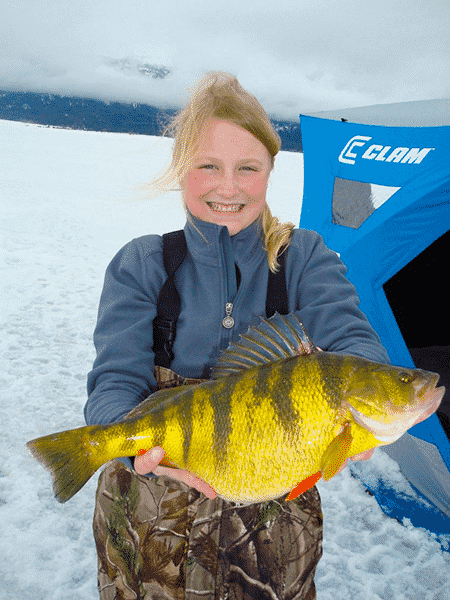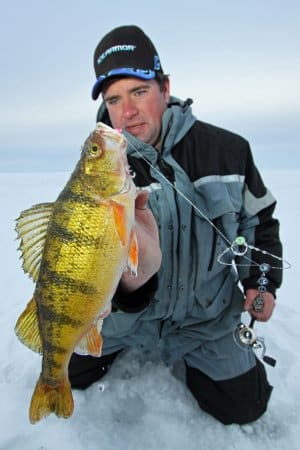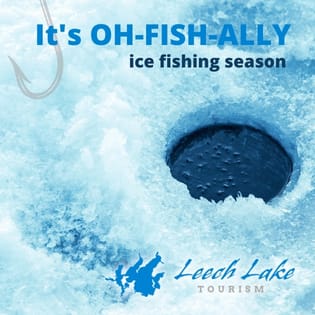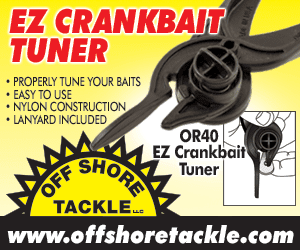Walleyes anglers tend to tightly hug dropoffs rimming the perimeters of large mainlake structures meeting fairly deep water. Hard bottom along these edges often concentrates walleyes along twists and turns in the contour. Yellow perch, while often nearby, do not find these spots areas as inviting.
Perch are more soft-bottom basin critters, likely to munch on bloodworms or other insects and larvae emerging from the mud. Yet they are often found very close to structure—like literally just off the edges. As such, the transition from hard bottom at the base of a dropoff, to the soft bottom of the adjacent basin, is a perfect place for walleyes and perch to interface.
Fish vertically, right on the dropoff, you’re likely to catch walleyes, especially during the lowlight transition periods of sunrise and sunset. Fish a few feet or yards out onto the adjacent mud flat, and you’re probably going to run into perch, chiefly during the day. Perch are active and on the prowl when the sun shines. But once light levels drop, they tend to settle to the bottom, resting their little fin tips on the basin, like a kid plopping his elbows on the table at dinnertime. Magically, just about the time the perch bite begins to taper, the walleye bite begins to kick in, with bigger ‘eyes munching on their smaller relatives.
The best way to find perch is to find the dropoff along a prime midlake bar or hump, and then drill a swiss-cheese pattern of holes across the nearby basin. True, this is a relatively flat area, but don’t worry. This is where perch live and feed on critters that live in and emerge from the mud. Or on little minnows that happen to wander through their territory, making perch equal opportunity feeders.
In the shallow, dingy-water natural lakes of the eastern Dakotas, basins may only be 9 or 10 feet deep. In clear-water natural lakes in Minnesota and Wisconsin, the best perch areas might be in the 20- to 30-foot range. In both cases, it’s the soft basin immediately adjacent to prominent mainlake structures that attract perch throughout the winter months.
Catching perch is usually easy; their abundance and competitive nature tends to make them biters as opposed to lookers. A simple 1/16- to 1/32-ounce jig tipped with a crappie minnow is usually adequate for catching them. Just lower it to the bottom on 2- to 4-pound-test line, lift it up and down a few times to disturb the mud and draw their attention, and then hold it still. Substitute a soft, 1-inch-long plastic tail if the fish are somewhat aggressive.

A small jigging spoon, tipped either with a minnow head, or several waxworms threaded onto the tines of the treble hook, also does the trick. It’s a more aggressive presentation than a jig, with more flash, vibration action. Downsize slightly from your typical walleye spoon; spoons that are an inch long and weighing around 1/16-ounce are about right. Once again, bang the bottom at least occasionally, and then hold the spoon slightly off bottom, allowing it to slowly twist on a taut line beneath the hole.
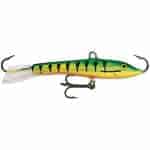 Small, #5 Jigging Rapalas are ideal for perch. They bang bottom, swim and swirl on the drop, and are lifelike in appearance. Tip a minnow head on one tine of the treble hook if they’re fussy, just like you’d dress an ice spoon.
Small, #5 Jigging Rapalas are ideal for perch. They bang bottom, swim and swirl on the drop, and are lifelike in appearance. Tip a minnow head on one tine of the treble hook if they’re fussy, just like you’d dress an ice spoon.
